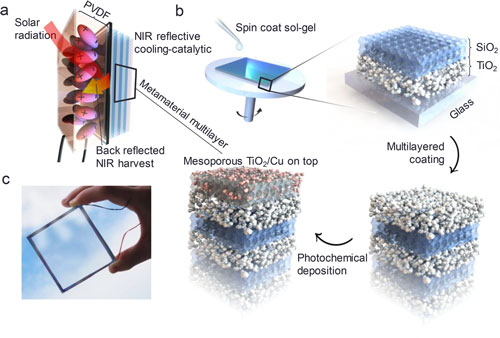| Posted: Feb 14, 2018 | |
Photothermal management with engineered nanophotonics(Nanowerk News) A new report in ACS Nano ("Nanophotonic-Engineered Photothermal Harnessing for Waste Heat Management and Pyroelectric Generation") proposes the use of low-cost and scalable nanophotonic multilayered structures for reutilizing waste thermal emission from solar reflective film for simultaneous passive daytime cooling and energy generation. |
|
| One of the main challenges for most solar pyroelectric technology lies in the limited thermal fluctuation harvesting. Unlike any other pyroelectric scheme, this novel design deviates from the conventional by deliberate channeling of the reflected near-infrared heat onto pyroelectric material so as to offer a recurring chance of heat propagation (photon recycling), resulting in an enhanced solar pyroelectric output. | |
 |
|
| (a) Schematic of nanophotonic-ferroelectric concept for thermal nanophotonics and (b) the deposition pathway that leads to thermal nanophotonics. (c) Photograph of the thermal nanophotonic-pyro prototype. (© ACS) (click on image to enlarge) | |
| Specifically, a metamaterial is coated on the indoor side to meet the strict cooperative demands for heat reflection, visible transmission, and also UV absorption for respective cooling, transparency, and photocatalysis, while the pyroelectric film is coated on the other side to harvest the reflected waste heat and solar insolation fluctuation for electric power output. | |
| Using the photonic nanostructure approach, flexible tunability in strong suppression of waste heat uptake and nonconflicting enhanced thermal harvesting that operate reliably at ambient outdoor condition can be realized. | |
| The team's theoretical simulations on the influence of the back reflected light on solar pyroelectric conversion testify the appreciable gain in temperature and electric potential distribution. | |
| To demonstrate the effectiveness of their design, the team demonstrted real outdoor solar reflective cooling up to 4.2°C and maximum pyroelectric Voc of -126.5 nA and Isc -32.2 V. | |
| "Our work offers conceptual and technological possibilities for broad implications in other solar optical and heat manifestations such as photovoltaic/thermophotovoltaics, thermoelectric energy conversion, nanoscale heat management, photodetectors, smart window, optical data storage, etc.," the authors conclude. |
 By
Michael
Berger
– Michael is author of three books by the Royal Society of Chemistry:
Nano-Society: Pushing the Boundaries of Technology,
Nanotechnology: The Future is Tiny, and
Nanoengineering: The Skills and Tools Making Technology Invisible
Copyright ©
Nanowerk LLC
By
Michael
Berger
– Michael is author of three books by the Royal Society of Chemistry:
Nano-Society: Pushing the Boundaries of Technology,
Nanotechnology: The Future is Tiny, and
Nanoengineering: The Skills and Tools Making Technology Invisible
Copyright ©
Nanowerk LLC
|
|
|
Subscribe to a free copy of one of our daily Nanowerk Newsletter Email Digests with a compilation of all of the day's news. |
